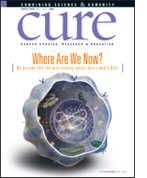Neil Spector: Getting the Right Drug to the Right Patient
Following the approval of breast cancer drug Tykerb and a pediatric leukemia drug, researcher Neil Spector, MD, works on ways to better develop and test cancer drugs
Herceptin (trastuzumab) was approved in 1998 as treatment for metastatic breast cancer, marking the beginning of the era of targeted therapies. While the drug, which targeted the HER2 receptor on the surface of breast cancer cells, became the next great hope in cancer therapy, Neil Spector, MD, was developing a small-molecule compound at GlaxoSmith-Kline called GW572016, now known as Tykerb (lapatinib).
With the success and publicity of Herceptin, Spector’s team convinced the company to test the compound in breast cancer.
“It turned out to be fortuitous that it was developed initially in breast cancer, because I’m not sure if it wouldn’t be sitting on a back shelf if it was developed in the other manner it was supposed to be developed in,” Spector says.
Because Tykerb blocks the HER2 receptor as well as the epidermal growth factor receptor (EGFR), there were initial discussions about pursuing the drug’s ability to block EGFR since Herceptin already worked well against HER2-positive cancers.
“But it turns out they’re very different,” Spector says. “It’s like comparing apples and oranges.” For one, they’re not cross-resistant, meaning women who progress on Herceptin may still respond to Tykerb, and now there are studies combining the two drugs.
At GSK, Spector led the translational research program, bridging the gap between the laboratory and the clinic. His goal was to try to understand and use the mechanisms of a compound to select the right patients for treatment and to minimize drug resistance. Spector succeeded in seeing not only Tykerb approved, but also a pediatric leukemia drug called Arranon (nelarabine).
“Both of them were similar in the sense that it was a matter of finding … the right drug for the right individual. Companies develop targeted therapies and then lose sight of the fact that they are targeted and they may not work in 100 out of 100 people. They may work in 15 or 20, but if you can identify those 15 or 20, that’s a great therapy for those people.”
Spector says the field of oncology is moving away from treating cancer based on where it originates in the body, such as in the breast, lung, or colon. “That’s just the way oncology has treated [patients] in the past, but unfortunately it hasn’t been the most successful approach,” he says, noting that Tykerb and Arranon are examples of how drugs take advantage of pathways and receptors in cancer cells.
Duke
Comprehensive
Cancer
Center
Now, as director of translational research in oncology at and co-director of its Experimental Therapeutics Program, Spector is working on how to better develop and test cancer drugs. Currently, only a small percentage of drugs that make it out of preclinical testing are approved, a lengthy and expensive process—one that Spector says shouldn’t take 15 years and $500 million.
"We can't lose the opportunity to find something that will make a big impact because we didn't have the insight in how to develop it properly. We have a lot of targeted therapies, but we really need the insight in how to use them in the clinic. That's one of the biggest challenges."
